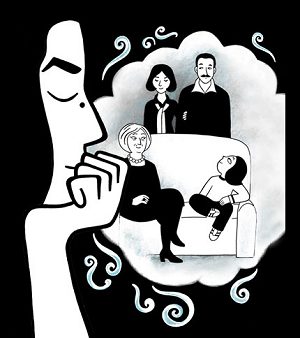Serendip is an independent site partnering with faculty at multiple colleges and universities around the world. Happy exploring!
Notes Towards Day 6 (Thurs, Feb. 2): Growing Up Graphic

I. Coursekeeping
sign in
relevant to our discussions: "Who cares about class?"
SJPP colloquium/collaborative workshops with lunch,
this Sat, 11-2:30, in Dalton 300
webevent due Friday night @ 8 p.m.
reminder that whenever you miss class (for whatever reason),
I'll be expecting an extra post from you that week-->
read the class notes and others' postings, then post something
of "what you might have said," had you been here for the conversation
trying again to demonstrate dchin's growing portfolio!
/exchange/portfolio/dchin
for Tuesday, read Gayatri Spivak's "Three Women’s Texts and a
Critique of Imperialism." Critical Inquiry 12, 1 (Autumn 1985). 243-261.
Available through JStor and also (heavily marked!) in our password-protected file.
a very difficult piece of feminist theoretical work (by a very difficult woman,
who calls herself a "practical-Marxist-feminist-deconstructivist" & critiques
the "imperialist axiomatics" of Jane Eyre and Frankenstein--
and of the concept of "meritocratic individualism" created thereby;
I'm going to use it to get us thinking about the "western-ness" of feminism,
esp. the context-specificness of our valorization of "the individual";
(among other things!) Spivak problematizes the way we use female
Bildungsroman (like Persepolis) as archetypal feminist texts
Spivak is affiliated with the Subaltern Studies Group;
subaltern refers to persons who are socially, politically,
and geographically outside of the hegemonic power structure
(=non-elite actors, the colonized, esp. in South Asia), so
important in getting us to thinking outside our conventional
frames of understanding/what we think is important.
And/but in choosing her text, I took a bet/risk that
you would know the two classic novels she discusses....?
(If you don't, watch Jane Eyre this weekend!
Or read plot summaries of that novel and Frankenstein!)
okay, on to other dimensions of our shared "cultural capital":
how are we doing on learning one another's names?
today's relevant name game--> something visually distinctive
do we need a hand up?
"I am Anne, and I am @ least 30 years older than anyone else in the room."
Re-naming, on the left: This is ---, and she is ----.
II. On Tuesday, we began to discuss the visual/graphic dimensions of Satrapi's work.
The best essay I know of, on this topic, is Hilary Chute's "The Texture of Retracing in Marjane
Satrapi's Persepolis." Women's Studies Quarterly 36, 1&2 (Spring/Summer 2008): 92-110:
Satrapi's stark style is monochromatic --
there is no evident shading technique;
she offers flat black and white ....
"the depiction of deliberately empty spaces" ...
frequent scenes in which public skirmishes appear as
stylized and even symmetrical formations of bodies ...
to present events with a pointed degree of abstraction
in order to call attention to the horror of history ...
a flatness of composition to intensify affective content
"I cannot take the idea of a man cut into pieces and just write it.
It would not be anything but cynical. That's why I drew it"
... from a child's ... perspective ....
child's eye rendition of trauma ...
haunts the text because of its incommmensurablity
... the author draws a scene of death... as a child imagines it ....
in a form keyed to structural gaps through the frame-gutter sequence...
... no perspective, however informed, can fully represent trauma ....
it is in "excess of our frames of reference" .... [In] a child's imaging of torture ...
one recognizes not only the inadequacy of any representation to such traumatic history,
but also ... the simultaneous power of the radically inadequate (the child's naive confusion).
Persepolis shows trauma as ordinary, both in the text's form -- the understated, spatial
correspondences Persepolis employs to narrative effect through comics panelization --
and in style: the understated quality of Satrapi's line that rejects the visually laborious ...
to departicularize the singular witnessing ... to open out the text ... while Persepolis
may show trauma as (unfortunately) ordinary, it rejects the idea that it is
(or should ever be) normal ....
Persepolis offers not simply a "visibility politics,"
but an ethical and troubling visual aesthetics...
III. Within this representation of trauma, Satrapi
tells us the story of a little girl, growing up.
Today let's turn to look @ this text as a form of
"autographics"--->graphic versions of autobiographies.
On Tuesday I had asked what it means, in the history of women-as-visual object,
to create a visual text about a woman's life: What is the effect?
What role do the words play in this graphic narrative?

Hilary Chute (continued): Some of today's most riveting feminist cultural production is in the form of accessible yet edgy graphic narratives....."graphic narratives"...destabilize standard narratives of history .... bridging wartime-focused testimonies and child-oriented testimonies ...Persepolis is about the ethical verbal and visual practice of "not forgetting" ... modeling a feminist methodology in its form, in the complex visual dimension of its author narrating herself on the page as a multiple subject.
(Or, in Tuesday's terms, retells an "outside" public story "from the inside.")
Let's spend some time today on that "inside," sharing our sense of who Marjane is.
Find a page (or 2) with an interesting intersection of text-and-image;
turn to the "visual object" next to you, and share this with her.
Returning to the large group:
How "individual"/how "doubled"/coherent/fragmented is Marjane in this form?
What's the difference between what she SAYS and how she is SEEN?
What can we see of her internal life?
IV. Our by-now standard form: is this feminist?
What do we think of autobiography as a feminist genre?
Absolutely: "representing the voices of the unrepresented"?
Or absolutely not: in its focus on the individual self?
What is the role of the collective, the larger whole?
Or of other small parts? Or: who lacks voice or vision here?
Who is not represented, when the self represents itself?
The two NYTimes articles about female suicide bombers might be useful here,
as foils to the Marjane's educated, individualized, independent, secular, Western p.o.v.
(One reason her text has been so popular in the West: we can easily see ourselves in her....)
Nancy K. Miller, "The Entangled Self: Genre Bondage in the Age of the Memoir." PMLA 122, 2 (2008): 537-548.
"Memoirs from sites of danger provide a safe space for readers to ponder the nightmare of contemporary global relations, even as the pages display the extreme difficulty of living in times of traumatic history. The story of the other citizen, preferably female--the exotic, foreign self in translation (like us after all)--is also a valuable template in the marketplace of contemporary autobiographical production and consumption."
the female autobiographical self ... goes public with private feelings through a significant relation to an other .... the other provides the authorizing conditions for self production .... "Isolate individualism is an illusion" .... Autobiography's story is about the web of entanglement in which we find ourselves .....
The reader ... is the autobiographer's most necessary other ....
You conjure the reader to prove that you are alive ....

V. But there are very different worlds of women in the Middle East , "not like us after all."
Where are the literary texts that represent them?
Can literary feminism be feminism, if it depends on written representation?
And most of the world's women can't read or write?
How to represent those who cannot represent themselves?
(who are not trained in art school, as Satrapi was?)
Spivak's "Can the Subaltern Speak?" (a founding text of postcolonial studies) focuses on
suttee, the religious practice (banned by the British in 1829), in which a recent widow
would immolate herself on her husband's funeral pyre. Spivak points out that all accounts
of what suttee meant to (or how it oppressed) women are re-presentations (by British
colonizers or Hindu leaders), but there are no records by the suttee-performing brown women
themselves: "the subaltern cannot speak."
Anat Berko, Path to Paradise: The Inner World of Suicide Bombers and Their Dispatchers (2009):
an Israeli researcher who tried "to open a window for the reader
into the inner world of men and women who blow themselves up" -->
"Western society, for which human life is the supreme value, finds it
difficult to define and understand the suicide bomber's behavior" (p. 12)
"Now we're just passing through. Real life is in paradise...
in fact he isn't dead, he's in paradise and he's still alive" (p. 159)
"For the suicide bombers, such dreams [of paradise] are a concrete reality" (p. 171)
"It's more impressive when a woman carries out a suicide bombing attack,
because this is the Middle East and a woman is very limited,
and that makes her action special" (p. 112)
"female suicide bombers...were the expression of a unique wave of feminism,
which allowed them to improve their social status" (p. 114) 



